
Concept explainers
(a)
Interpretation:
The Lewis dot structure for TeCl2 must be drawn.
Concept Introduction :
Lewis dot structure is the representation of a molecule using valence electrons shown as dots.
Te is a p block element of group 16 with 6 valence electrons.
(a)
Answer to Problem 5E
Lewis dot structure for TeCl2 is given below.

.
Explanation of Solution
In TeCl2, Te is the central atom which is bonded to two Cl atoms. There are three lone pairs of electrons on each Cl atom and two lone pair of electrons on Te atom.
Thus, the Lewis dot structure is as follows:

(b)
Interpretation:
The Lewis dot structure for HI must be drawn.
Concept Introduction :
Lewis dot structure is the representation of a molecule using valence electrons shown as dots.
I is a p block element of group 17 with 7 valence electrons.
(b)
Answer to Problem 5E
Lewis dot structure for HI is given below.

.
Explanation of Solution
In HI, I is bonded to one H atom. There are three lone pairs of electrons on I atom and hydrogen has zero lone pairs.
The structure is represented as follows:

(c)
Interpretation:
Lewis dot structures for AsBr3 must be drawn.
Concept Introduction :
Lewis dot structure is the representation of a molecule using valence electrons shown as dots.
As is a p block element of group 15 with 5 valence electrons.
(c)
Answer to Problem 5E
Lewis dot structure for AsBr3 is given below.
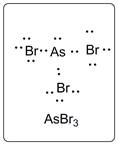
.
Explanation of Solution
In AsBr3, As is the central atom which is bonded to three Br atoms. There are one lone pair of electrons on As atom and three lone pairs of electrons on Br atom.
The structure is represented as follows:
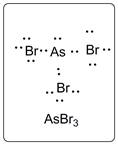
(d)
Interpretation:
Lewis dot structures for SiF4 must be drawn.
Concept Introduction :
Lewis dot structure is the representation of a molecule using valence electrons shown as dots.
Si is a p block element of group 14 with 4 valence electrons.
(d)
Answer to Problem 5E
Lewis dot structure for SiF4 is given below.
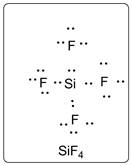
.
Explanation of Solution
In SiF4, Si is the central atom which is bonded to four F atoms. There are three lone pairs of electrons on F atom.
Structure is represented as follows:
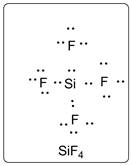
(e)
Interpretation:
Lewis dot structures for F2 must be drawn.
Concept Introduction :
Lewis dot structure is the representation of a molecule using valence electrons shown as dots.
F is a p block element of group 17 with 7 valence electrons.
(e)
Answer to Problem 5E
Lewis dot structure for F2 is given below.
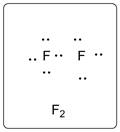
.
Explanation of Solution
In F2, both the F atoms are bonded to each other with a single bond. There are three lone pairs of electrons on each F atom.
The structure is represented as follows:
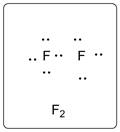
Chapter U2 Solutions
Living By Chemistry: First Edition Textbook
Additional Science Textbook Solutions
Human Anatomy & Physiology (2nd Edition)
Campbell Essential Biology with Physiology (5th Edition)
Human Biology: Concepts and Current Issues (8th Edition)
Campbell Biology (11th Edition)
Microbiology: An Introduction
Biology: Life on Earth with Physiology (11th Edition)
- Protecting Groups and Carbonyls 6) The synthesis generates allethrolone that exhibits high insect toxicity but low mammalian toxicity. They are used in pet shampoo, human lice shampoo, and industrial sprays for insects and mosquitos. Propose detailed mechanistic steps to generate the allethrolone label the different types of reagents (Grignard, acid/base protonation, acid/base deprotonation, reduction, oxidation, witting, aldol condensation, Robinson annulation, etc.) III + VI HS HS H+ CH,CH,Li III I II IV CI + P(Ph)3 V ༼ Hint: no strong base added VI S VII IX HO VIII -MgBr HgCl2,HgO HO. isomerization aqeuous solution H,SO, ༽༽༤༽༽ X MeOH Hint: enhances selectivity for reaction at the S X ☑arrow_forwardDraw the complete mechanism for the acid-catalyzed hydration of this alkene. esc 田 Explanation Check 1 888 Q A slock Add/Remove step Q F4 F5 F6 A བྲA F7 $ % 5 @ 4 2 3 & 6 87 Click and drag to start drawing a structure. © 2025 McGraw Hill LLC. All Rights Reserved. Terms of Use | Privacy Ce W E R T Y U S D LL G H IK DD 요 F8 F9 F10 F1 * ( 8 9 0 O P J K L Z X C V B N M H He commandarrow_forwardExplanation Check F1 H₂O H₂ Pd 1) MCPBA 2) H3O+ 1) Hg(OAc)2, H₂O 2) NaBH4 OH CI OH OH OH hydration halohydrin formation addition halogenation hydrogenation inhalation hydrogenation hydration ☐ halohydrin formation addition halogenation formation chelation hydrogenation halohydrin formation substitution hydration halogenation addition Ohalohydrin formation subtraction halogenation addition hydrogenation hydration F2 80 F3 σ F4 F5 F6 1 ! 2 # 3 $ 4 % 05 Q W & Å © 2025 McGraw Hill LLC. All Rights Reserved. F7 F8 ( 6 7 8 9 LU E R T Y U A F9arrow_forward
- Show the mechanism steps to obtain the lowerenergy intermediate: *see imagearrow_forwardSoap is made by the previous reaction *see image. The main difference between one soap and another soap isthe length (number of carbons) of the carboxylic acid. However, if a soap irritates your skin, they mostlikely used too much lye.Detergents have the same chemical structure as soaps except for the functional group. Detergentshave sulfate (R-SO4H) and phosphate (R-PO4H2) functional groups. Draw the above carboxylic acidcarbon chain but as the two variants of detergents. *see imagearrow_forwardWhat are the reactions or reagents used? *see imagearrow_forward
- The two pKa values of oxalic acid are 1.25 and 3.81. Why are they not the same value? Show the protontransfer as part of your explanation. *see imagearrow_forwardасть Identify all the bonds that gauche interact with C-OMe in the most stable conformation of the above compound.arrow_forwardPredict the reactants used in the formation of the following compounds using Acid-Catalyzed dehydration reactionarrow_forward
 ChemistryChemistryISBN:9781305957404Author:Steven S. Zumdahl, Susan A. Zumdahl, Donald J. DeCostePublisher:Cengage Learning
ChemistryChemistryISBN:9781305957404Author:Steven S. Zumdahl, Susan A. Zumdahl, Donald J. DeCostePublisher:Cengage Learning ChemistryChemistryISBN:9781259911156Author:Raymond Chang Dr., Jason Overby ProfessorPublisher:McGraw-Hill Education
ChemistryChemistryISBN:9781259911156Author:Raymond Chang Dr., Jason Overby ProfessorPublisher:McGraw-Hill Education Principles of Instrumental AnalysisChemistryISBN:9781305577213Author:Douglas A. Skoog, F. James Holler, Stanley R. CrouchPublisher:Cengage Learning
Principles of Instrumental AnalysisChemistryISBN:9781305577213Author:Douglas A. Skoog, F. James Holler, Stanley R. CrouchPublisher:Cengage Learning Organic ChemistryChemistryISBN:9780078021558Author:Janice Gorzynski Smith Dr.Publisher:McGraw-Hill Education
Organic ChemistryChemistryISBN:9780078021558Author:Janice Gorzynski Smith Dr.Publisher:McGraw-Hill Education Chemistry: Principles and ReactionsChemistryISBN:9781305079373Author:William L. Masterton, Cecile N. HurleyPublisher:Cengage Learning
Chemistry: Principles and ReactionsChemistryISBN:9781305079373Author:William L. Masterton, Cecile N. HurleyPublisher:Cengage Learning Elementary Principles of Chemical Processes, Bind...ChemistryISBN:9781118431221Author:Richard M. Felder, Ronald W. Rousseau, Lisa G. BullardPublisher:WILEY
Elementary Principles of Chemical Processes, Bind...ChemistryISBN:9781118431221Author:Richard M. Felder, Ronald W. Rousseau, Lisa G. BullardPublisher:WILEY





